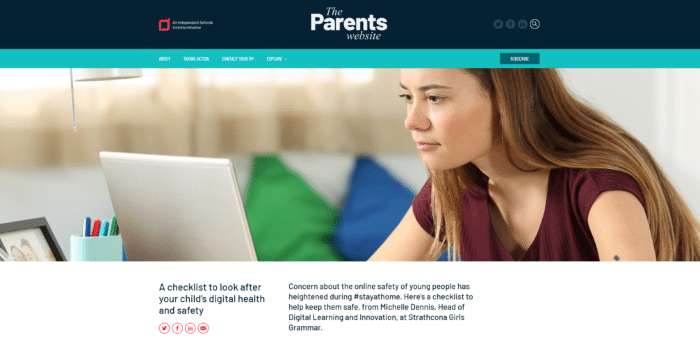In the Media: The Parent Website, 12 May 2020.
Concern about the online safety of young people has heightened during #stayathome. Here’s a checklist to help keep them safe, from Michelle Dennis, Head of Digital Learning and Innovation, at Strathcona Girls Grammar.
Home learning presents many challenges for the young student population and one area that risks being overlooked is the increased need for vigilance when it comes to ensuring their cyber safety and wellbeing. But parents can help their children to stay safe and healthy when they’re spending more time online by following this simple checklist.
Be aware of location settings on all devices at home
It’s important for family privacy that location settings for all apps are turned off — including Facebook, Snapchat, TikTok, Instagram and others. If one person in the household has their location settings on, that can put everyone else’s privacy at risk so it’s good practice to disable this setting on all devices being used by your child and the rest of the family.
Revisit boundaries around what can and can’t be shared on social media
It will come as no surprise that posted digital content has skyrocketed in the last few weeks as people’s face-to-face interactions are restricted. While this can be a great way to stay connected with others, it’s timely to remind children that whatever they post or share can leave a permanent digital footprint that could affect them in the future and may even have legal consequences.
When young people communicate in online forums with friends, they can have a false sense of privacy and may say things that they wouldn’t necessarily say in face-to-face conversations. What’s more, the things they say in this environment can easily be captured and shared by others. Remind your child to avoid saying things online that they wouldn’t want shared. If there is a disagreement or conflict playing out online, encourage them to take the conversation to a private phone call or video chat to resolve more discreetly.
You might be surprised to learn that girls receive 10 times more unsolicited text or online messages than boys. Ensuring that your child’s social media settings restrict direct messages from people they don’t know can protect them from unwanted approaches. Encourage your child to be wary of socialising or sharing personal information with someone they haven’t met face-to-face before.
Make sure your child has a good support network
While technology allows us to do amazing things (like learning from home!), the internet and social media can also expose children to cyberbullying, harassment and unsolicited messages. It’s important for parents to check in regularly with their child to see how they’re going and make it clear that they have someone to turn to if something happens to go wrong, such as yourself, a teacher, or another trusted adult.
Children may be afraid that their devices will be taken away from them if they tell an adult about a problem they are having online. Reassure them that you’re there to help them with any trouble they may be having and not to stop them from socialising with their friends. Have the contact details for your child’s school technology leader or pastoral support mentor handy so you can promptly alert them to any matters that may require school intervention. If your child reports something worrying happening online, try to take a screenshot of the incident. You can also find lots of information on cyber safety for families on the E-safety commissioner website.
Set ‘technology free’ times
With children already spending so much time online for school, as well as using social media and other apps to connect with friends, it’s important to ensure they are getting a break from their screens each day and that they have time for winding down and connecting with their family. Implementing a ‘technology free’ time can be as simple as setting a rule for no phones at the dinner table, or a family walk where devices are left at home. You should also consider limiting your child’s phone use at night and adjusting their phone screen to its night setting after sunset as the blue light of the phone screen has been linked to poorer sleep quality.
Keeping online activity out in the open
While it can be challenging for parents and children to work and learn from home together, try to set up your child’s study space in a more public part of the house where you can monitor their behaviour, moods and facial expressions and intervene if you sense they’re upset or worried about something happening online. One silver lining of the highly unusual situation we currently find ourselves in is that there is more opportunity than ever for parents to participate in their child’s learning experience and to guide them safely in an online world.


